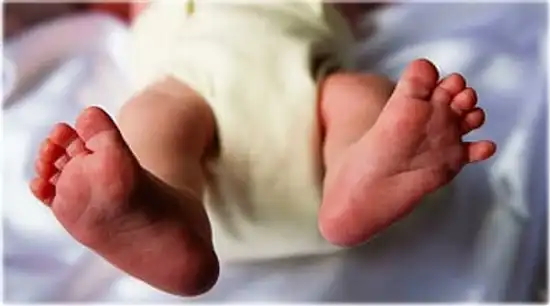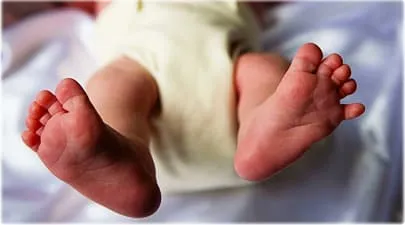Baby Quiz: Is My Newborn Typical?

It's normal for a newborn to have:
Pimples or whiteheads
Red rash on the neck
Small red dots or red areas on the belly
All of the above
It's normal for a newborn to have:
A baby's skin is soft -- but it's not always unblemished! Most of the bumps and red spots aren't anything to be worried about and will go away. White bumps on the nose, chin, or cheeks are very common. So is baby acne. Both usually clear up on their own. And red spots on your baby's belly that look like bites are also pretty common and go away in a week or two.
A red, pimply rash in neck folds or behind the ears -- places where skin is moist -- could be prickly heat. It even has a coarse, sandpaper feel. Wash the skin gently with plain cool water and pat -- don’t rub -- dry.
If you are worried about any rash or if your child is sick or has a fever, call your pediatrician. It’s always better to be safe than sorry!

What causes cradle cap?
Psoriasis
Allergies
Dry skin
No one knows for sure
What causes cradle cap?
No one knows for sure what causes cradle cap -- flaky skin that looks like dandruff or yellow, crusty patches on a baby's head. But many newborns have it. It may also show up on a baby's ears, eyebrows, eyelids, or even underarms. It's not contagious and probably won't bother your little one. If it bothers you, you can gently massage your baby's scalp with your fingers, shampoo more often (be sure to rinse away all shampoo), and brush your baby's scalp with a very soft brush.

Why do some newborns have pointy heads?
From squeezing through the birth canal
From being upside down in the womb
Both
Why do some newborns have pointy heads?
No doubt your little one is a PERFECT angel -- but they may not look the part at first. If you had a vaginal birth, the bones of your baby's head shifted and overlapped so they could pass through the birth canal. That tends to make for a pointy, cone-shaped head. No need to worry -- the baby's head will get more rounded in about a week. Babies delivered buttocks first or feet first, or by cesarean section, may not have elongated heads.
It's also common for babies to have some swelling and bruising toward the top of the back of their heads, or a lump on one side of the head caused by blood collecting under the scalp. There’s usually nothing to worry about -- your baby's brain is fine. But if it seems large, it's a good idea to have your doctors check it.

My newborn has lost weight in the week since I brought them home. Should I be worried?
No, a little is normal
Yes, call your doctor
My newborn has lost weight in the week since I brought them home. Should I be worried?
Babies will lose 6 to 8 ounces during the first week, and babies that weighed more at birth may lose even more. When they start to gain weight, expect them to gain 4 to 7 ounces a week for the first few weeks, then about 1 pound or slightly more a month for the first 6 months. Babies are born with enough fluid and fat to keep them going until they get into a regular feeding routine. Check with your doctor if you have concerns.

The best way to make sure your baby is getting enough to eat is to time their feedings.
True
False
The best way to make sure your baby is getting enough to eat is to time their feedings.
Breastfed babies generally nurse every 2 to 3 hours during the first few weeks, formula-fed babies every 3 to 4 hours. You'll also want to pay attention to your baby's cues, as well as how they eat -- and how they poop! Your little one should seem satisfied for 1 to 3 hours between feedings. Granted, that can be a tough call -- babies suck when they're hungry, but also to comfort themselves.
Dirty diapers are another clue. Most newborns have six or more wet diapers a day and two or more bowel movements.
The first few weeks can be hectic, and keeping track of feedings helps create some structure while you learn to recognize your baby's hunger cues.

It's easy for all babies to latch on to the breast.
True
False
It's easy for all babies to latch on to the breast.
Many babies need help at the beginning. Some key tips include: Bring the baby's mouth to your breast and use your finger to make sure both of their lips are spread out. You may feel pain for a few seconds at the beginning, but it should get better. If it doesn't, stop the feeding briefly and try again. Ask your health care provider for help if you or your baby are having trouble.

A baby's stools are usually black.
True
False
A baby's stools are usually black.
A baby's first poops are a thick black or dark green, but after that, the color in their diaper should be yellow-green. If it's black, red, or white, see your pediatrician.
If your baby is breastfed, their poops will be a light mustard color. If your baby is formula-fed, they'll be darker. It's normal for the color or consistency to change once in a while. Hard or dry stools may be a sign that they need more to drink.

It's normal for newborns to have:
Strange breathing noises
Crooked feet
Eyes crossed
All of the above
It's normal for newborns to have:
Yes, your little angel comes with some weird features! No need to worry -- they usually go away on their own. For instance, it's very common for newborns to breathe rapidly or pant, or even have 10-second periods when they don't take a breath. As for your baby's tiny, kissable feet -- after months of living in cramped quarters in the womb, they're often turned in. Help them out by gently stretching the front of their foot and not letting them sleep in the fetal position.
And it may take up to 8 weeks for baby’s eyes to stay straight. Their eyes may also be bloodshot from the pressure of a vaginal delivery. What about the color? You won’t really know for sure until they are about 6 months to a year old. Always check with your doctor if you're concerned.

My baby's soft spot bulges when they cry! Is that normal?
Yes, usually normal
You should call your doctor
My baby's soft spot bulges when they cry! Is that normal?
Your baby has two soft spots on their head: a larger one toward the front of the top of the head and a small one toward the back. They may bulge when they cry, and you may be able to see the pulse of their heartbeat there, too. Those soft spots let the baby's large head move through the birth canal and give their big brain room to grow fast after they are born. The smaller soft spot usually disappears in 6 months. The larger one may take 12 to 18 months to close completely. They are covered by a tough membrane that protects the brain. If your baby's soft spot continues to bulge -- even when they are not crying -- see your doctor.

As long as you diaper the right way, your baby won't get diaper rash.
True
False
As long as you diaper the right way, your baby won't get diaper rash.
Fact is, almost all babies have diaper rash at some point. It happens most often between 4 months and 15 months, and is more noticeable when babies start to eat solid foods. A lot of things can cause diaper rash: diapers that are moist, dirty, or too tight; frequent stools; antibiotics; and a bad reaction to soaps. Solutions include: changing diapers often; allowing your baby's bottom to air-dry; diaper rash cream; patting the baby dry rather than rubbing; loose-fitting diapers.
Tell your doctor if the rash lasts more than a few days or if your baby has sores on the skin.

In the first few days, a newborn may have:
Yellow skin
Bluish hands and feet
Both
In the first few days, a newborn may have:
Many babies get jaundice -- which turns their skin yellow -- within 3 or 4 days of birth. Usually it goes away within a week, but you should always check with your doctor if your baby looks yellow or has jaundice to make sure there's not a more serious problem.
Your baby's hands and feet may look a little blue on and off for a few days after birth. In most cases it's normal, due to the fact that their circulatory system hasn't quite matured yet. Always check with your doctor to make sure there is nothing else more serious going on.

When the stump of your baby's umbilical cord falls off, it may bleed a little.
True
False
When the stump of your baby's umbilical cord falls off, it may bleed a little.
You may see a few drops of blood on your baby's diaper when the umbilical cord stump falls off. Before it falls off, make sure you keep the cord dry and clean as it shrivels up. It should fall off within 2 weeks.
It's rare for the stump to get infected. Signs would be a bad-smelling discharge from the cord, red skin around the base of the cord, or if the baby cries when you touch the cord or skin next to it. If you see any of these, or if the area seems to be bulging, call your doctor.

How often do you need to trim a baby's nails?
Every day
Once a week
Once a month
None of the above
How often do you need to trim a baby's nails?
A baby's nails grow fast! The best time to trim them is when they are in deep sleep. Use small clippers made just for babies. Push on the finger pad to move it away from the nail before you snip.